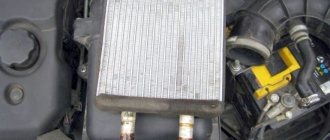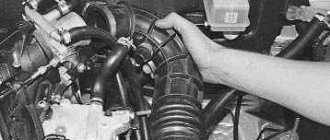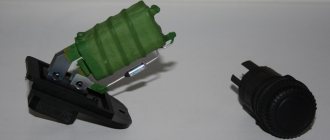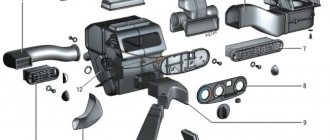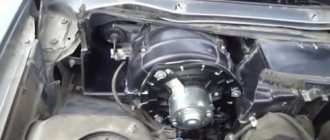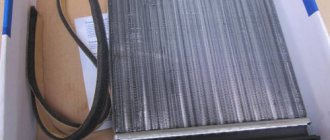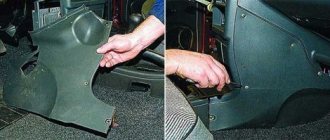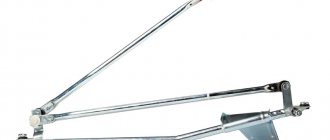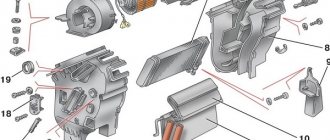During operation, a car engine inevitably gets hot, and to prevent its parts from overheating, a cooling system is used. One of its most important parts is the radiator, in which the coolant cools to optimal temperatures. This prevents excessive heating of the power plant parts. Without cooling, the engine will inevitably overheat and fail.
How to replace the radiator of a Priora stove with air conditioning
A failed stove in winter is a very serious problem for the owner of any car, including the Lada Priora. It should immediately be noted that there can be many reasons why a breakdown occurred. Sometimes it will take very little time to eliminate them, but in some cases you will have to tinker. However, often there is nothing particularly complicated in such work, and it is quite possible to do it yourself, even if you have never done anything like this before.
How to replace the heater radiator of a Lada Priora with air conditioning
As mentioned above, there can be many reasons why warm air has stopped flowing into the cabin while the heater is on. First, let's briefly look at the design features of the Priora heating system, as well as its main elements. There are no particularly complex electronic devices here - everything is done quite simply, and therefore reliably. The stove on the VAZ-2170 is of a liquid design, and it is combined with the engine cooling system. In fact, here is a classic scheme where antifreeze is heated and warm air is supplied to the car interior. The main elements of the system are:
- radiator;
- fan;
- 2 dampers, with which you can regulate the strength of the flow of warm air and its distribution among the zones of the cabin.
For those who have previously had to deal with the heating systems of VAZ cars, there is essentially nothing new here. The coolant is heated in the radiator, after which the warm air is blown into the passenger compartment by a fan. The driver is able to regulate the intensity of the flow, as well as distribute it throughout the cabin.
It should also be noted that Priora can be found in two different trim levels - with and without air conditioning. In the first case, VAZ installs devices from Panasonic or HALLA on the model 2170. At the same time, cars with air conditioning turned out to be more convenient in terms of maintenance and repair of the heating system, since access to its components was significantly simplified.
In particular, in order to remove the radiator, it is no longer necessary to dismantle the decorative trim of the windshield. In addition, there is no need to remove the wiper arms. There is also no need to remove the brake booster and heater. All this saves a lot of time; accordingly, all the necessary work can be done faster than on a Priora without air conditioning. Yes, there shouldn’t be any difficulties with this.
In order to remove the heater radiator on a Priora with air conditioning, you will need a minimum set of tools. In particular, you should take:
- wrenches - 8, 10 and 13;
- Phillips screwdriver;
- container for draining coolant.
Having prepared everything you need, you can start working.
The first step is to remove the rubber seal from the windshield trim - this is necessary in order to gain access to the components we need. The next stage is dismantling the middle part of the engine compartment sound insulation. To do this, you must first remove the hoses from the mounts. It should be noted that in the upper part the sound insulation in the Priora engine compartment is held in place by 3 self-tapping screws, in the lower part by 3 screws, 2 nuts and a washer. Some of the mounts are quite difficult to reach, so it is recommended to use special tool extensions.
After the middle part of the sound insulation is removed, you will see a foam rubber seal - it covers the stove radiator. To dismantle the cover, you will need to unscrew the 3 screws available here - 2 are located at the edges, the third is in the middle. As a result, we have already reached the pipes - they will also need to be removed. To do this, you must first loosen the clamps holding them. After this, you need to carefully, without tilting the hoses down, pull the pipes up. That's all - all that remains is to pull the heater radiator towards you. This also needs to be done quite carefully, without making serious efforts. Pull the radiator towards you until it comes out of the corresponding fasteners.
It should be noted that it is not necessary to drain the coolant when performing such work in a Priora with air conditioning. Antifreeze will only come out of the expansion tank, and a very small part of it will come directly from the radiator itself. It was said above that the Prior family is equipped with air conditioners from different manufacturers, but this point does not in any way affect the sequence of actions when removing the heat exchanger. The differences here are quite insignificant - only in the number of fasteners. Well, the work itself, as you can see, is very simple. You should not have any particular difficulties when removing the heater radiator. If you are doing this kind of work for the first time, just take your time and remember to be careful.
How to replace the cooling radiator on a VAZ 2170-VAZ 2172?
1) Before you start work, drain all the coolant from the radiator (How to drain the liquid, read “here”) and proceed to removing the electric fan (If you don’t remove it, you simply won’t be able to pull out the radiator), to do this, first disconnect the negative terminal with the battery, loosen the bolt that secures it, then remove the air filter housing because it will interfere very much (Read “here” how to do this), well, you can start removing the electric fan, first disconnect the wiring from each other, wiring the electric fan has a connector and block on the side (see photo 1), then unscrew (it’s most convenient to use a wrench) two bolts that secure the electric fan to the casing on the left and four nuts, two of which are located on the top and two below (see photos 2 and 3 below) and then remove the electric fan by pulling it to the top and putting it aside.
2) Next, remove the sound signal, because it will not allow you to remove the radiator (For information on how to do this, read the article: “Replacing the signal on the Lada Priora”) and then loosen all the clamps that secure all the supply pipes to the radiator (see. photos 1 and 2, pay attention to photo 1, there is another pipe indicated by an arrow, so don’t miss it) and disconnect them, immediately after which unscrew the two nuts that secure the radiator to the body (see photo 3) and then remove a holder that keeps the hose from dangling from the hole in the cross member of the engine compartment (see photo 4), and that’s it, you can safely then tilt the radiator towards the car engine and then pull it out of the engine compartment.
Look again at photo 1 above, there the arrow indicates the upper hose, unlike the pipes, it is attached not with a worm clamp, but with a tape clamp, tape clamps are not convenient and after the first unscrewing, it is already difficult to secure the hose with them so that it holds just as tightly, Therefore, replace this clamp (If you have a band clamp) with a worm clamp, it is much more convenient and can be tightened with a wrench or a screwdriver!
Before installing a new radiator or re-installing an old one (if you solder it), check for the presence of two cushions on which the radiator stands (see photo 1), they sometimes still remain in the mounting pins, so look everywhere for torn or lost elasticity cushions, replace them with new ones , as well as remove and check the rubber-metal bushings; if necessary, they are also replaced with new ones.
If you still decide to install the old radiator (Perhaps you simply removed it in order to gain access to other parts), then before installing it, rinse it outside with a stream of water and dry it thoroughly, and by the way, before connecting the pipes back to the radiator, Lubricate them with sealant, a small layer, otherwise the pipes may begin to leak, which will cause you a lot of inconvenience and problems with the constant purchase of coolant!
Study the video below, using the example of a VAZ 2111 car, it shows how to properly remove the radiator from the car.
Replacement option for a car without air conditioning
The replacement of the radiator of the Priora stove without air conditioning begins with zeroing the negative terminal of the battery. Then the windshield trim is removed along with the wiper seats to facilitate the work process. The further operation is performed in stages:
- The tubes supplying the refrigerant to the injectors are removed.
- The cover is removed by unscrewing seven screws.
- The tightening element on the hood seal is unscrewed.
- The flat plugs on the engine sound insulation are pryed off and turned out.
- The insulating elements are removed along with the linings.
- The clamps on the radiator pipes are loosened and removed. You will need to prepare a container for draining the antifreeze.
- The wiring connected to the heater is removed.
- The wire holder is removed and moved to the side.
Replacing the heater radiator on a Priora with and without air conditioning
With the onset of cold weather, the driver's interest in the operation of the heater increases sharply. The motorist checks the stove for various faults. In some cases, a radiator failure is detected. How is the radiator of a Priora stove replaced? As a rule, this component cannot be repaired and must be replaced. Having opened the dismantling manual, the driver may discover that the parts in his Priora are located differently than in the instructions. It's all about the air conditioner. The process of removing the heater radiator in older versions of Priora without this option differs from dismantling it in new cars where air conditioning is already present. We will look at both options.
Modern Priors are equipped with Halla or Panasonic air conditioners. There are differences in the operation of the two models, but the location of their installation does not differ, depending on the air conditioner brand, so the process is the same. As an example, we will consider a Priora with Halla air conditioning.
Symptoms of a problem
The Lada 2170 model received a liquid heater, which is connected to the engine cooling system. The radiator is a heat exchange device; due to this component, the air entering the Priora’s cabin is heated. Coolant constantly circulates through the radiator; this part of the heater is subject to wear.
It is worth checking the radiator in the following cases:
- The stove stopped heating properly.
- The coolant level drops.
Once you disassemble part of the heater system, you will see a rusty and most likely leaking radiator. There may also be leaks in hoses, pipes and the junctions of these elements. You should check the heat exchanger of the stove only after you have made sure that there are no defects in the operation of the gearmotor and damper.
Replacing the radiator of the Priora stove
To work, you will need a standard set of tools, which includes socket wrenches 10 and 13, side cutters, a Phillips screwdriver, and a wrench 8. In both cases, you will have to disconnect the heating system hoses; the remaining coolant will pour out of them, so immediately place containers under the pipes heater Then the liquid can be returned to the system.
With air conditioning
- First of all, we need to remove the rubber seal of the windshield to gain access to the parts;
As you can see, dismantling the radiator in a Priora with air conditioning does not require draining the antifreeze. Coolant will only come out of the expansion tank and the heat exchanger itself. Removing the radiator in a VAZ 2170 with Panasonic air conditioning follows the same scheme, only a few fasteners may differ. Now you can replace your worn-out heater with a new one!
Without air conditioning
- Work begins by disconnecting the negative terminal of the battery. We remove the windshield trim along with the windshield wiper arms, as these elements will interfere with operation;
- The next step is to remove the coolant supply pipes to the engine injectors;
- The windshield trim is held in place by seven screws. Unscrew it to completely remove the element;
- Now we move on to the hood seal, in its center you will find a tightening screw - unscrew it;
- The engine noise insulation closes the passage to the heater system - pry up the plugs with a flat screwdriver and unscrew the plugs;
- We unscrew the screws and dismantle the sound insulation. Remove both covers;
Clean the heat exchanger and inspect it for damage. If cracks are found on the plastic elements, then you will no longer be able to repair the part - only replacing the stove radiator on a Priora, which is done in the reverse order, will help here.
- Priora instrument panel: indicator designations, error interpretation
- Do-it-yourself PTF Priora installation
- Signs of malfunction, replacing the speed sensor on a Priora
Enter the text of the comment: the climate control does not work, not old, not new, the heater damper opens and closes all the way to the MMR, I change it every year in the spring, the damper does not close, I have to remove the MMR in the fall, everything is new on the computer, the regulator works
I unscrewed the 4 screws that hold the plastic plate near the heater radiator pipes, but for some reason it does not come out of the heater. Priora with Panasonic. I would be grateful if you could tell me.
Step-by-step instructions for replacing the engine radiator on a VAZ 2170 Priora:
— First of all, drain the antifreeze/antifreeze from the system. To do this, open the expansion tank, then unscrew the drain plug, after placing a container under it.
— Remove and carefully pull out the fan casing, to do this you need to disconnect the wires and unscrew the fasteners.
— We remove the signal
— Next, loosen the clamps and disconnect the compression and outlet pipes.
— Unscrew the radiator mounts to the body...
...then disconnect the fastening element of the expansion tank hose to the front panel.
— Loosen the hose clamp and disconnect it.
— After this, you can pull out the radiator and remove the 2 lower cushions and mounting bushings.
Note: to repair the radiator yourself, rinse it thoroughly and inspect it for cracks in the plastic elements. If they are discovered, it will not be possible to repair it. If not, then plug the pipes and lower them into water. Apply air to detect leaks.
— replacing the radiator on a VAZ 2170 occurs in the reverse order (do not forget to first install the lower mounting pads and the upper mounting bushings).
You can also apply a thin layer of sealant before connecting the hoses to prevent further leaks.
— Install the fan with a casing, fill with antifreeze.
Replacing the radiator of a heating device in a Lada Priora car
Almost every motorist who owns a domestic vehicle discovers a malfunction of the car’s heating unit in the winter. After all, only with the onset of severe cold does a person begin to think about how to avoid freezing while driving a car. Naturally, everyone uses a stove for this.
However, what should those for whom this very device has ceased to function properly do? After all, only the heater can ensure that the cabin maintains a normal temperature, allowing for comfortable movement.
In this article we will look at only one reason why the heating device stops working, we will learn about the principles of repairing and replacing the heater radiator installed in a Lada Priora car.
If the motorist is sure that it is necessary to replace the heater core, it may take a lot of time to eliminate the faulty object, since most likely, in the process it will be necessary to replace not just a blown fuse, but to carry out more serious repair work. True, you should not immediately despair because of your ignorance; the material contains detailed instructions to help everyone understand how to replace the stove radiator in a Priora with and without air conditioning.
Replacing the radiator of a heating unit in a Priora that is not equipped with air conditioning
Replacing the heater radiator on a Priora without air conditioning may make sense if warm air has stopped flowing into the cabin, while the heater itself is working. If, in addition to the above problem, there is also a water leak from under the Priora stove, the motorist will have to remove the poorly functioning unit in order to solder the latter. Sometimes repairs are impractical and you have to replace the old device with a new one.
So, first of all, you need to start by removing the negative terminal from the battery. The fact is that the issue here is not only about the safety of the master himself, but also about additional insurance, which allows him to avoid several unpleasant surprises that, if handled carelessly, can arise not only with wiring, but also with electrical equipment.
If you are replacing the heater radiator on a Priora without air conditioning, after de-energizing the system, you can begin to dismantle the windshield trim. At the same time, the wiper levers, which can cause future discomfort during operation, should also be removed.
After this, you should rid the unit of all plastic tubes through which the liquid located in the windshield washer reservoir goes directly to the nozzles. Only after all the above steps have been completed will it be possible to remove the decorative trim located along the edges of the windshield.
In fact, it’s easy to carry out such a manipulation - just get rid of seven self-tapping screws.
Replacing the heater radiator on a Priora can only be done after removing the hood seal. Before dismantling, it should be noted that in the middle of the lining there is a screw that tightens both halves of the structure. Using a screwdriver or any knife, you can gently lift the plugs (this element serves as the “cover” of the screw) and unscrew them.
After this, you can begin to remove the sound insulation, which is located in the power unit compartment. To do everything correctly, you will have to unscrew the screws and remove the pads (there is no clear rule about which of them to remove first: left or right). Then you should get rid of the pipes that go directly to the radiator. A person who wants to understand how to get to the heater radiator on a Priora must loosen the clamps holding the structure itself.
After this, you can remove all the wires going directly to the stove from the connectors. You can remove them using two keys, in particular, one “10” and the other “8”. After unscrewing all four nuts, move the wiring harness to the side, which is held by the holder.
The “13” key will help to dismantle the bracket located on the brake pedal. Only after this can you begin to remove the heater radiator on a Priora that does not have air conditioning. A regular Phillips screwdriver will help you dismantle the device, allowing you to remove 3 screws.
All the rest of the work consists of installing a new unit and reassembling the system in the reverse order of the described actions.
In fact, there is another way to replace the system element of interest. To open free access to this element, dismantling not the stove body, but the vacuum brake booster will help. It is worth noting that this procedure will only be successful if the brake pedal is removed along with it. Such actions help to get closer directly to the left side of the stove and the desired device.
Conversion of VAZ 2110 into Priora
Replacing knock sensor Priora 16 valves
Salon:
- Priorovsky salon in a VAZ 2110 - installation of wiring, panels (dashboard), door trim, ceiling trim, airbags, tunnel (beard), interior lighting, plastic elements of door pillars, seats.
- Review of armrests - among other options, there is also the installation of an armrest from Priora.
- Priora steering column switches on the VAZ 2110 - installation of Priora/Kalina/Niva-Chevrolet steering column switches.
- Pockets in the door trim of the VAZ 2110 - among other options, there is the installation of Priora door pockets.
- Heater unit knobs - installation of heater unit adjustment knobs from Priora without air conditioning.
- Gear shift drive n/o - installation of a new model of the backstage from Priora.
- Instrument panel with navigation from Priora on VAZ 2110 and Kalina 1
- The steering wheel is from a new Priora model in the top ten without any modifications.
Body, external parts:
- Bumper from Priora for VAZ 2110 - modification of the bumper or crossing.
- Semi-Priora, semi-VAZ 2110 - interchangeability of body parts of Priora and "Tens".
- Priora windshield for VAZ 2110 - installation of a frill.
- Priorovsky rear-view mirrors on the VAZ 2110 - installation of mirrors.
- Euro handles for the VAZ 2110 - among other options, there is the installation of Priora door handles.
- Door sills from Priora - installation of Priora decorative door sills on a VAZ 2110.
- Windshield wiper trapezoid - installation of a wiper trapezoid from Priora on a VAZ 2110.
Engine compartment:
- Priorovsky expansion tank for VAZ 2110 - installation of the tank.
- VUT and GTZ Priora on VAZ 2110 - installation of a vacuum brake booster and master brake cylinder.
- Priorovsky adsorber on VAZ 2110 - installation of an adsorber.
- Priora front suspension on the VAZ 2110 - installation of shock absorbers, struts and suspension springs.
- Air conditioning on a VAZ 2110 - installation of an air conditioner or some of its elements.
- The best engine cooling radiator for a VAZ 2110-12 - which Priora cooling radiator is suitable for the “Ten”.
- Replacing the alternator belt, if there is power steering - installing the Priora alternator belt.
- Engine from Priora - installation of engine 21126 on a VAZ 2110
- Expansion tank - installation of a coolant reservoir from Priora.
- Crankcase protection - installation of protection for the internal combustion engine and gearbox from Priora.
Noise, vibrations, seals:
- Door window seals and Priora velvet guards on the VAZ 2110 - installation of velvet guards and edging for the side windows of the Priora on the “Ten”.
- Priorovsky gutters on VAZ 2110 - installation of Priora windshield gutters.
- Additional door seals for VAZ 2110 - among other options, there is the installation of Priora door seals.
Electrical:
- ESD on VAZ 2110 - installation of Priora electric power steering.
- Electric drive of the heater damper on the VAZ 2110 - installation of a stepper electric drive of the dampers and the SAUO Priora unit.
Miscellaneous:
- Rear beam of Priora on VAZ 2110 - installation of a beam from Priora.
- Anti-roll bar suspension - installation of a Priora stabilizer.
- Modification of the gas tank cap of the VAZ 2110 - installation of the Priora gas tank cap.
xn--2111-43da1a8c.xn--p1ai
Radiator malfunctions and their consequences
A broken device poses a great danger to the entire cooling system, since its instability can lead to overheating of the power plant. The Lada Priora uses a standard combined cooling system, when the liquid system is supplemented by an air system. Thanks to this combination, it is possible to more effectively maintain the optimal engine temperature under various loads and operating modes.
There are not many malfunctions of this element as such. The main problem with the radiator is the occurrence of coolant leakage. This happens due to a violation of the integrity of the tubes caused by damage to the radiator. Another common problem is clogging of its inner surface. This can be determined due to the constant operation of the forced cooling fan.
The temperature drops, but rises quickly and causes the ventilation unit to turn on again, even when driving at high speed. This is due to the fact that the oncoming air flow cannot cool the coolant due to dirty plates. Contaminants can also be deposited on the inner walls of the radiator tubes, which will impede the circulation of antifreeze. And, as a result, the engine will begin to heat up excessively.
When the device is broken, the power unit overheats.
Causes of malfunctions
The main factors causing problems with the radiator are the following:
- wear of elements of a natural nature (any part sooner or later wears out and fails);
- mechanical impacts leading to damage and deformation;
- operating the engine in violation of the manufacturer's requirements and recommendations.
Breakdown can be caused, among other things, by the use of low-quality coolant, mixing antifreeze with other types of antifreeze, and the use of all kinds of sealants that can clog the pipes and affect the circulation of the coolant (coolant). At the same time, the human factor cannot be ignored when, due to incompetence in matters of radiator maintenance and repair, a part has to be replaced.
Often, simple dirt and poplar fluff that clog the plates can cause the engine to heat up. Due to systematic overheating, the fuel in the cylinders begins to detonate due to the increased temperature of the coolant. As a result, the cylinder head burns out, the block itself becomes deformed from high temperatures, and cracks appear. And ultimately, the destruction of the piston group and crank mechanism completes the picture. It's not far from a major, expensive engine overhaul.
You need to carefully monitor the condition of the cooling system and the radiator in particular.
Signs of trouble
Even a beginner can determine that there are some problems with the radiator. This does not require special knowledge. It is enough to understand in general terms the principle of operation of the cooling system of the Lada Priora.
Troubleshooting
| Symptoms | What are they related to? |
| On the instrument panel, the arrow of the coolant temperature indicator constantly approaches the red zone. | This provokes the inclusion of forced cooling and indicates engine overheating. |
| Constant overheating can also be determined by the deposit on the spark plugs. | During normal engine operation, the coating is sand-colored; when overheated, it is white. |
| It is necessary to carefully monitor the level of coolant in the expansion tank. | A sharp or gradual decrease in level will indicate the presence of a leak, which may be associated with a leak in the radiator. |
Low coolant levels will also lead to rapid overheating. It is easy to find a leak by characteristic smudges on the surface, as well as by the presence of antifreeze or antifreeze where the car is parked.
Fan doesn't work
But sometimes another problem occurs with the Priora stove. The driver turns the heater switch, and in response there is silence. The electric motor is not working. What is the reason. There may be several of them:
- The fan motor burned out.
- The heater control unit has failed.
- The fan speed resistor has burned out.
- Broken electrical wiring.
The easiest way to determine if a resistor is broken. In this case, only the maximum speed is turned on, and the stove does not respond to other positions of the handle.
The control unit is checked either by computer diagnostics or by a simple replacement. There are no other options.
The condition of the electric motor can be determined by checking with a test lamp. It is enough to remove the top frill and gain access to the motor connector. Disconnect this connector and insert a test lamp instead of the chip going to the fan. When you turn on the stove handle, the light should light up if the unit and wiring are working properly. If there is no signal, start checking the wires sequentially. If the lamp lights up, replace the electric motor.
Replacing the motor
Although Hallo and Panasonic fan electric motors differ in size and installation point, they have one thing in common. Their location is in a vertical position. This allows you to dismantle them without removing the entire heater. As with a standard heater, the heater fan motor on a Priora with air conditioning is secured with 3 screws.
So, replacement. As in the case of a radiator, first of all you need to open access to the stove. That is, remove the frill and protection. Then disconnect the electrical connector. Now just unscrew the 3 fastening screws and remove the fan with the motor. That's it, you can install a new unit in its place. But this is only for the Hallo heater. With the Panasonic compressor, everything is somewhat more complicated. The fact is that it is also separated from the engine compartment by a plastic casing. According to factory documentation, it is necessary to remove the entire heater to replace the electric motor. And this is draining and refilling freon. But our craftsmen found a way out.
Cut the protection at the narrowest point approximately in the middle of the compartment and remove it by unscrewing 2 fasteners. After this, access to the part being replaced is open. Sometimes, however, in most cases, the engine mount prevents you from pulling out the motor. Don't panic. This problem can be solved by disassembling the motor on site. That is, separate it into 2 halves and pull them out separately. Then insert a new one using the same method.
But still, just in case, before replacement, it is better to consult with car service specialists in advance about possible refilling of the air conditioner with freon in case of damage. This is to replace the motor. But with a radiator, such problems, as a rule, do not happen.
How to replace a stove radiator yourself without an air conditioner
What will be needed for replacement? First of all, the following tools:
- Screwdrivers, figured and flat.
- Wrenches for 8 and 10. (preferably heads with a wrench.)
- Thin pliers for removing clamps.
And, of course, some materials and devices:
- Container for coolant from the system.
- New radiator.
- Foam rubber adhesive strips for the radiator of the Priora stove.
- 2 liters of coolant. (same brand as in the system.)
- Rags.
Having prepared such an arsenal, you can begin this interesting operation of replacing the heat exchanger.
Process description
Place the car level. This is necessary to completely drain the coolant from the radiator of the Priora stove. Place a container for liquid under the bottom of the car. It must be installed in the area of the radiator drain hole of the cooling system. On the right side (along the direction of the car, or on the left, if you stand near the hood). Next you need:
- Unscrew the screw cap and allow the liquid to drain. When the pressure weakens, open the cap of the expansion tank. Wait for the drain to drain and tighten the plug. Disconnect the negative battery terminal. You can begin dismantling the protection. It's called frill.
- First, the windshield wipers are removed. Using a 13mm wrench, unscrew the fastening nuts and remove the brush holders. After this, remove the rubber seal.
- Unscrew the fastening screws. There are 6 of them on top and 7 along the bottom edge. Now remove both halves of the plastic frill. After unscrewing the fasteners, remove the fabric protection of the glass niche in which the stove is installed.
Now comes the most crucial moment. Most craftsmen, when replacing this part, immediately disconnect the pipes going to the radiator of the Priora stove. However, there is a risk of dousing the heater parts with coolant. There is a more interesting and safer option.
Removing the stove
Now that the frill and protection have been removed, access to the heater is completely open. First of all, you need to disconnect the electrical connectors:
- Micromotor gearbox for damper drive. 2 connectors.
- Electric fan. 1 connector.
- Resistor. 1 connector.
Now unscrew the fastening of the heater body to the car body. One 10mm nut secures the eye on the stove body to the right wing. 8 secures the top to the stud at the top. And two nuts at the bottom.
Once the fasteners are removed, the fun begins. Using a flat screwdriver, remove the 3 screws securing the radiator to the body
You need to act carefully so as not to break off the side, thin pressure relief pipe. After that, remove the screws holding the 2 parts of the heater housing. Move the left part with the fan motor a little to the left, disconnecting them, and pull it out
Move the left part with the fan motor a little to the left, disconnecting them, and pull it out.
After this, you can begin to remove the second half with the radiator. Hold the pipes with your hand and begin to remove the body to the left. When it comes off, set it aside. After releasing the clamps from the pipes, remove them from the radiator.
Necessarily! Place a rag under the radiator, as there is always some liquid left and you should not pour it on the engine compartment.
Installation (replacement) of a new radiator
There are two options here. You can simply replace it by putting the part in place of the old one, before installing the housing. But it is better to install the radiator in the removed half before attaching the pipes.
Important! Be sure to cover the radiator with foam tape! This creates a safety cushion for the part. Having decorated the heat exchanger of the stove with foam, install it in the niche of the housing and secure it with screws. Place the half in place and secure all 3 pipes in place
Tighten the clamps
Place the half in place and secure all 3 pipes in place. Tighten the clamps
Having decorated the heat exchanger of the stove with foam, install it in the niche of the housing and secure it with screws. Place the half in place and secure all 3 pipes in place. Tighten the clamps.
Carefully reassemble the heater in reverse order. Add coolant to normal level. Start the engine and wait for the cooling fan to operate. Press the accelerator pedal and hold the speed at about 2,000 rpm for a couple of minutes. This is necessary to eliminate a possible air lock. Turn on the heater and check its operation in all modes. All! Well, the necessary work has been done.
- Removing the CV joint
- How to determine a CV joint failure
- Computer diagnostics of the Priora heater control unit
- How to fix the stove in a Lada Priora car
Removing, replacing, installing a cooling system radiator
Removing a Prior generator with air conditioning
01/05/2013 at 03:01
Symptoms: the engine is poorly cooled, traces of coolant on the radiator of the cooling system, coolant decreases from the system too quickly.
Possible cause: the radiator of the cooling system is damaged.
Tools: socket set, wrench set, Phillips screwdriver, compressor.
Note. If defects are detected, the radiator should be replaced, since its repair is possible only in a specialized workshop.
1. Drain the coolant from the system.
2. Disconnect the negative cable from the battery.
4. Disconnect the wiring harness plug from the electric fan.
5. Unscrew and remove the two bolts securing the fan shroud on the left, and then unscrew the two nuts securing the fan shroud on the top.
6. Unscrew the lower fastening nut of the fan casing.
7. Remove the electric fan assembly with its casing.
9. Unscrew and remove the three lower screws securing the front bumper to the left and right front fender guards.
10. Unscrew the four screws securing the front bumper to the upper cross member of the front end of the body, and then unscrew the two screws securing the right and left headlight housings to the bumper.
11. Unscrew and remove two fastening screws of the bumper to the front fenders on the left and right from the side of the wheel arches, and also unscrew one fastening screw each to the left and right fender liners of the front fenders.
12. Remove the bumper by moving it forward.
13. Unscrew and remove the three mounting bolts of the bumper beam to the lower body cross member.
14. Remove the beam.
15. Remove the wiring harness connector from the horn.
16. Unscrew the fastening nut, and then remove the bracket along with the sound signal.
17. Loosen the fastening clamp of the supply hose to the radiator.
18. Disconnect the supply hose from the radiator pipe.
19. In the same way, remove the outlet hose from the pipe located on the radiator.
20. Unscrew the two nuts securing the radiator to the car body.
21. Remove the steam hose holder from the slot in the upper cross member of the engine compartment.
22. Move the radiator towards the engine, and then loosen the steam hose band clamp.
23. Disconnect the hose from the fitting located on the radiator.
Note. It is recommended to replace the removed band clamps with worm-type clamps during assembly.
24. Remove the radiator by pulling it up.
25. Disconnect the two lower mounting pads from the radiator (if they are still on the radiator mounting pins) or remove them from the holes in the cross member (if they are still on the body). When installing, replace torn or inelastic cushions.
26. Remove the rubber-metal bushings from the radiator brackets. Replace torn or inelastic bushings with new ones.
27. Rinse the radiator under running water and then dry it.
28. Inspect the plastic radiator tanks for cracks. If cracks are present, the radiator should be replaced.
29. Check the radiator for leaks by plugging its pipes and placing them in a container of water. Supply air to it at a pressure of 0.1 MPa. No gas bubbles should appear from the radiator for at least thirty seconds.
30. Install the new radiator in the reverse order of removal, having previously installed the lower mounting pads on its pins and mounted the upper mounting bushings into the brackets.
Note. Before connecting hoses to the radiator, apply a thin layer of sealant to the radiator pipes.
31. Install the fan and other dismantled parts in the reverse order of removal.
32. Charge the cooling system.
Pavel Kurakin Car enthusiast
Main aspects of repair
If the fan does not work or the stove generally stops working, then you need to understand that the repair process is a rather labor-intensive procedure. Before you remove the heater radiator on a Priora or how to remove the fan, you need to do diagnostics. First, the functionality of the thermostat is checked. If the lines connected to the device are warm, then the part is working.
If the fan does not work, first of all you need to check its contacts. Replacing the stove fan does not always solve the problem, especially if it involves oxidation of the contacts. Sometimes simply cleaning the connector from the device is enough to solve the problem. You can always remove the heater fan, but the heater fan does not fail very often. If the stove blows only at maximum speed, the stove rotation speed resistor has burned out.
Diagnostics of climate control Priors luxury equipment
Like all electronic control units (ECUs), the heater/air conditioning computer is diagnosed either with a portable scanner or with a full-fledged motor tester. It should be borne in mind that this system is controlled through a separate ECU called the comfort unit.
Just like standard diagnostics, the climate control system scan is connected via the OBD-2 diagnostic connector under the glove box. In general, these tests are carried out in a similar way to diagnosing an automatic heating system. With air conditioning features. That is, checking the actuators and sensors of this device.
The culprit is the radiator
There are a huge number of malfunctions of the interior heater, but the main one is a malfunction of the heater radiator. The reasons why the stove does not heat in winter may be a clogged radiator, both outside and inside.
The cost of a heater radiator with a hall air conditioner is from 1,500 to 2,500 rubles.
If the radiato is clogged from the outside:
It happens that when using a car without a cabin filter, excess debris may fall onto the radiator of the heater, which under the influence of the heater fan can clog it.
In order to eliminate this ailment, it is enough to remove the radiator and wash it.
The heater radiator is clogged from the inside:
There are cases where the radiator becomes clogged from the inside due to old coolant. Corrosion products accumulate on the thin walls of the radiator and clog it, which prevents antifreeze from entering and passing through. Therefore, if the coolant cannot circulate normally through the radiator, then it will not be able to heat up and give off heat.
Eliminated by removing the radiator and flushing.
Heater radiator leak:
When the radiator leaks, an unpleasant odor appears in the cabin, the car windows begin to fog up and become covered with a greasy coating. Driving such a car becomes uncomfortable; if there is a large coolant leak, there is a chance of losing a large amount of antifreeze and overheating the engine, which can lead to expensive repairs.
Replacing the air conditioner radiator in Priora Halla
Radiator leaking on Priora? Don't know what radiator you need? In this article we will briefly describe how to choose the right radiator for a VAZ 2170.
In total, Priora can have up to three radiators:
1) engine cooling radiator,
2) air conditioner radiator (condenser),
3) heater radiator or stove radiator.
Let's talk about the main engine cooling radiator. When selecting, you need to check whether your car has an air conditioner, since in a Priora with air conditioning, an air conditioning radiator is additionally installed, so the engine radiator is made thinner and with different mounts. This entails an increase in its price due to a more complex design, since with a smaller size it is necessary to achieve the same heat transfer.
If you need to replace the radiator on a VAZ 2170 Priora with air conditioning, you should check which air conditioner you have: PANASONIC or HALLA.
This can be done by knowing their differences. Here are some of them:
1) the Panasonic system’s blower speed selection knob has about 16 positions, which provides fewer steps than Halla’s, which has 4 speeds.
2) under the hood, the Hall system lines are aluminum, while Panasonic’s upper line is a flexible black hose (the line is located to the left of the engine protective cover)
How to change the heater radiator on a Lada Priora
In fact, every motorist who owns a Russian vehicle discovers a malfunction of the car’s heating unit specifically in winter. After all, only with the advent of severe cold does a person begin to think about how to avoid freezing while driving a car. Naturally, everyone uses a stove for this. But what should those for whom this same device has stopped working properly? After all, only the heater is able to ensure that the normal temperature is maintained in the cabin, allowing for comfortable movement. In this article we will look at only one reason why the heating device stops working, we will learn about the principles of repairing and replacing the heater radiator installed in a Lada Priora car.
If the motorist is sure that the heater core needs to be replaced, it may take a lot of time to remove the faulty object, because most likely, in the process it will be necessary to change not just a blown fuse, but to carry out more serious repair work. True, one should not immediately despair because of one’s own ignorance; the material contains a carefully written annotation that helps everyone understand how to replace the stove radiator in a Priora with and without air conditioning.
Priora stove diagram
What is included in the heating system
The heater is located in the engine compartment in the area of the right windshield trim. It is attached to the front panel. The entrance to the heating system is occupied by a filter, which is responsible for cleaning the air used for heating and ventilation.
The design of the Priora stove consists of a number of elements:
- filter cover;
- filter, which is used for heating and ventilation;
- heater housing;
- micromotor gearbox;
- radiator;
- additional resistor on the fan;
- fan.
Principle of operation
In addition, the Priora heater device includes important components, without which normal operation of the stove would be impossible. These include the following mechanisms:
- The operation of the control unit is based on turning the knobs, each of which is responsible for one or another system parameter.
- The cabin temperature sensor allows you to maintain the required temperature at a constant level. This mechanism is located in the headliner trim.
- The additional resistor is located in the fan housing along with the fan, radiator, filter and damper.
- The radiator is connected through hoses to the system that cools the engine. During vehicle operation, coolant circulates from the engine to the radiator all the time. The heater is controlled by a damper, which changes the direction of outside air, directing it towards or past the radiator. The damper can be located in an intermediate position, which provides for the division of the external air flow: one part is directed to the radiator, and the other passes past it.
- The micromotor is responsible for controlling the movement of the damper. It is located on the left side of the body. The micromotor gearbox has an output shaft, which is connected to the axis on the damper.
This is exactly the design of the Priora stove (2010). But we have not yet considered all working issues.
Air flow distribution
As mentioned earlier, the heated air is distributed throughout the entire cabin, rather than blowing at one point. This heating turns out to be more efficient. Such heating features are provided for by the design of the Priora heater. The following elements are responsible for performing these functions:
- air ducts from the side deflector and glass blower;
- air distribution housing;
- flap;
- damper gear motor;
- air duct for blowing feet.
The air distribution housing and air ducts are mounted behind the instrument panel. Inside the air distributor housing there are dampers that are responsible for changing the direction of air flow. The rotation of the dampers is the result of a gearmotor, which is located on the air distribution housing.
When the car is moving, air enters the cabin under high-speed pressure. For this, holes are used that are located in the wind window trim on the right. To make the air flow more powerful and independent of the speed of the car, a heater fan is provided. The electronic fan motor can operate at four speeds.
Interior ventilation
The car interior should not be sealed; ventilation is an important point in maintaining a comfortable climate. The air comes out due to valves that are located on the trunk panel; they can be found behind the bumper. Opposite the valves, in the trunk lining, there are holes through which air escapes. Every Priora owner should know about such moments so that these holes remain open while loading the trunk. The diagram of a Priora heater without air conditioning, which is attached below, may also be useful.
